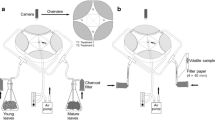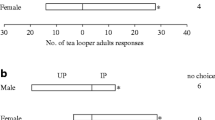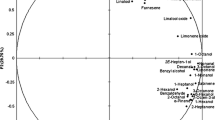Abstract
The silkworm Bombyx mori is a molecular genetic model for the Lepidoptera. Its odorant receptor genes have been described, and preliminary studies suggest that several are expressed specifically in the larval caterpillar stage. This study was undertaken to identify olfactory behaviors specific to the larvae. A two-choice leaf disk bioassay with naive neonate larvae was used to evaluate the attractiveness of three types of mulberry leaf (Morus alba): newly flushed leaves from branch tips, mature leaves, and mature leaves with feeding damage caused by conspecific larvae. Mature leaves with feeding damage were the most attractive, newly flushed leaves were moderately favored, and undamaged mature leaves were the least attractive. Volatile odors collected from whole mulberry leaves by using solid-phase microextraction fibers were analyzed by gas chromatography-mass spectrometry. The volatile profile of newly flushed leaves and mature leaves damaged by conspecific larvae was more complex compared to undamaged mature leaves. By comparing the volatile makeup of each leaf type, a list of 22 candidate odors responsible for attracting the neonate larvae was generated; α-farnesene was particularly notable as a herbivore-induced volatile. These odors will be used in future in vitro studies to determine whether they activate larval-specific odorant receptors.


Similar content being viewed by others
References
Anderson, A Z. R., Wanner, K. W., Trowell, S. C., Warr, C. G., Jaquin-Joly, E., Zagatti, P., Robertson, H., and Newcomb, R. D. 2009. Molecular basis of female-specific odorant responses in Bombyx mori. Insect Biochem. Mol. Bio. 39:189-197.
Beale, M. H., Birkett, M. A., Bruce, T. J., Chamberlain, K., Field, L. M., Huttly, A. K., Martin, J. L., Parker, R., Phillips, A. L., Pickett, J. A., Prosser, I. M., Shewry, P. R., Smart, L. E., Wadhams, L. J., Woodcock, C. M., and Zhang, Y. 2006. Aphid alarm pheromone produced by transgenic plants affects aphid and parasitoid behavior. Proc. Natl. Acad. Sci. U S A. 103:10509-10513.
Carroll, M. J., Schmelz, E. A., Meagher, R. L., and Teal, P. E. A. 2006. Attraction of Spodoptera frugiperda larvae to volatiles from herbivore-damaged maize seedlings. J. Chem. Ecol. 32:1911-1924.
Carroll, M. J., Schmelz, E. A., and Teal, P. E. A. 2008. The attraction of Spodoptera frugiperda neonates to cowpea seedlings is mediated by volatiles induced by conspecific herbivory and the elicitor inceptin. J. Chem. Ecol. 34: 291-300.
De Moraes, C. M., Mescher, M. C., and Tumlinson, J. H. 2001. Caterpillar-induced nocturnal plant volatiles repel conspecific females. Nature. 410:577-580.
Dicke, M., Gols, R., Ludeking, D., and Posthumus, M. A. 1988. Jasmonic acid and herbivory differentially induce carnivore-attracting plant volatiles in lima bean plants. J. Chem. Ecol. 25:1907-1922.
Goldsmith, M. R., Shimada, T., and Abe, H. 2005. The genetics and genomics of the silkworm, Bombyx mori. Annu. Rev. Entomol. 50:71-100.
Hamamura, Y. and Naito, K. 1961. Food selection by silkworm larvae, Bombyx mori. Nature. 190:879-880.
Hoballah, M. E. and Turlings, T. C. J. 2005. The role of fresh vs. old leaf damage in the attraction of parasitic wasps to herbivore-induced maize volatiles. J. Chem. Ecol. 31: 2003-2018.
Ishikawa, S., Hirao, T., and Ari, N. 1969. Chemosensory basis of host plant selection in the silkworm. Ent. Exp. Appl. 12:544-554.
James, D. G. and Price., T. S. 2004. Field-testing of methyl salicylate for recruitment and retention of beneficial insects in grapes and hops. J. Chem. Ecol. 30:1613-1628.
Kessler, A. and Baldwin, I. T. 2001. Defensive function of herbivore-induced plant volatile emissions in nature. Science. 291:2141-2144.
Kreher, S. A., Kwon, J. Y., and Carlson J. R. 2005. The molecular basis of odor coding in the Drosophila larva. Neuron. 46:445-456.
Krieger, J., Grosse-Wilde, E., Gohl, T., and Breer, H. 2005. Candidate pheromone receptors of the silkmoth Bombyx mori. Eur. J. Neurosci. 21:2167-2176.
Landolt, P. J., Brumley, J. A., Smithhisler, C. L., Biddick, L. L., and Hofstetter, R. W. 2000. Apple fruit infested with coddling moth are more attractive to neonate codling moth larvae and possess increased amounts of (E,E)-α-farnesene. J. Chem. Ecol. 26:1685-1699.
Mita, K., Kasahara, M., Sasaki, S., Nagayasu, Y., Yamada, T., Kanamori, H., Namiki, N., Kitagawa, M., Yamashita, H., Yasukochi, Y., Kadono-Okuda, K., Yamamoto, K., Ajimura, M., Ravikumar, G., Shimomura, M., Nagamura, Y., Shin-I, T., Abe, H., Shimada, T., Morishita, S., and Sasaki, T. 2004. The genome sequence of silkworm, Bombyx mori. DNA Res. 11:27-35.
Nakagawa, T., Sakurai, T., Nishioka, T., and Touhara, K. 2005. Insect sex-pheromone signals mediated by specific combinations of olfactory receptors. Science 307:1638-1642.
Pare, P. W. and Tumlinson, J. H. 1999. Plant volatiles as a defense against insect herbivores. Plant Physiol. 121:325-332.
Park, S. W., Kaimoyo, E., Kumar, D., Mosher, S., and Klessig, D. F. 2007. Methyl salicylate is a critical mobile signal for plant systemic acquired resistance. Science. 318:31-32.
Prokopy, R. J. and Roitberg, B. D. 2001. Joining and avoidance behavior in nonsocial insects. Annu. Rev. Entomol. 46:631-665.
Renwick, J. A. A. and Chew, F. S. 1994. Oviposition behavior in Lepidoptera. Annu. Rev. Entomol. 39:377-400.
Sakurai, T., Nakagawa, T., Mitsuno, H., Mori, H., Endo, Y., Tanoue, S., Yasukochi, Y., Touhara, K., and Nishioka, T. 2004. Identification and functional characterization of a sex pheromone receptor in the silkmoth Bombyx mori. Proc. Natl. Acad. Sci.U.S.A. 101:16653-16658.
Schneider, D. 1992. 100 years of pheromone research, an essay on Lepidoptera. Naturwissenschaften. 79:241-250.
Schoonhoven, L. M. 1987. What makes a caterpillar eat? The sensory code underlying feeding behavior, pp. 69-97, in R.F. Champman, E.A. Bernays and J.G. Stoffolanoeds (eds.). Advances in Chemoreception and Behavior. Springer, New York, New York.
Stamps, J. and Krishnan, V. V. 2005. Nonintuitive cue use in habitat selection. Ecology. 86:2860-2867.
Turlings, T. C., Loughrin, J. H., McCall, P. J., Rose, U. S., Lewis, W. J., and Tumlinson, J. H. 1995. How caterpillar-damaged plants protect themselves by attracting parasitic wasps. Proc. Natl. Acad. Sci. USA. 92:4169-4174.
Varela, L. G. and Bernays, E. A. 1987. Behavior of newly hatched potato tuber moth larvae, Phthorimaea operculella Zell. (Lepidoptera: Gelechiidae), in relation to their host plants. J. Insect. Behav. 1:261-275.
Wanner, K. W., Anderson, A. R., Trowell, S. C., Theilmann, D. A., Robertson, H. M., and Newcomb, R. D. 2007. Female biased expression of odourant receptor genes in the adult antennae of the silkworm. Bombyx mori. Insect Mol. Bio. 16:107-119.
Williams, L. 3rd, Rodriguez-Saona, C., Castle, S. C., and Zhu, S. 2008. EAG-active herbivore-induced plant volatiles modify behavioral responses and host attack by an egg parasitoid. J. Chem. Ecol. 34:1190-1201.
Xia, Q., Zhou, Z., Lu, C., Cheng, D., Dai, F., Li, B., Zhao, P., Zha, X., Cheng, T., Chai, C., Pan, G., Xu, J., Liu, C., Lin, Y., Qian, J., Hou, Y., Wu, Z., Li, G., Pan, M., Li, C., Shen, Y., Lan, X., Yuan, L., Li, T., Xu, H., Yang, G., Wan, Y., Zhu, Y., Yu, M., Shen, W., Wu, D., Xiang, Z., Yu, J., Wang, J., Li, R., Shi, J., Li, H., Li, G., Su, J., Wang, X., Li, G., Zhang, Z., Wu, Q., Li, J., Zhang, Q., Wei, N., Xu, J., Sun, H., Dong, L., Liu, D., Zhao, S., Zhao, X., Meng, Q., Lan, F., Huang, X., Li, Y., Fang, L., Li, C., Li, D., Sun, Y., Zhang, Z., Yang, Z., Huang, Y., Xi, Y., Qi, Q., He, D., Huang, H., Zhang, X., Wang, Z., Li, W., Cao, Y., Yu, Y., Yu, H., Li, J., Ye, J., Chen, H., Zhou, Y., Liu, B., Wang, J., Ye, J., Ji, H., Li, S., Ni, P., Zhang, J., Zhang, Y., Zheng, H., Mao, B., Wang, W., Ye, C., Li, S., Wang, J., Wong, G. K., and Yang, H. 2004. A draft sequence for the genome of the domesticated silkworm (Bombyx mori). Science 306:1937-1940.
Zalucki, M. P., Clarke, A. R., and Malcom, S. B. 2002. Ecology and behavior of first instar larval Lepidoptera. Annu. Rev. Entomol. 47:361-393.
Acknowledgments
We thank the Hanks’ lab for the use of the GC-MS and technical advice, Annie Ray and Emerson Lacey for their help with designing experiments and running the GC/MS, and Art Zangerl for assisting with volatile identification. We also thank the two anonymous reviewers for helpful comments that improved the manuscript. This research was funded by USDA NRI grant #2006-03826.
Author information
Authors and Affiliations
Corresponding author
Electronic supplementary material
Below is the link to the electronic supplementary material.
Supplementary Fig. 1
Volatile profile of filter paper exposed to mature mulberry leaves that were fed upon for 24 h by neonate silkworm larvae. One major peak (peak #C) representing α-farnesene was detected. Two minor peaks were identified as 6-methyl-5-hepten-2-one (peak A) and (Z)-3-hexenyl 2-methylbutanoate (peak B). Retention time (min) is labeled on the x-axis, relative abundance (×106) on the y-axis. (GIF 9 kb)
Rights and permissions
About this article
Cite this article
Mooney, A.C., Robertson, H.M. & Wanner, K.W. Neonate Silkworm (Bombyx mori) Larvae Are Attracted to Mulberry (Morus alba) Leaves with Conspecific Feeding Damage. J Chem Ecol 35, 552–559 (2009). https://doi.org/10.1007/s10886-009-9639-z
Received:
Revised:
Accepted:
Published:
Issue Date:
DOI: https://doi.org/10.1007/s10886-009-9639-z




